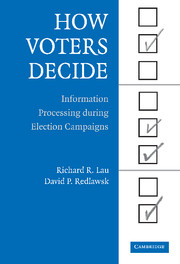Book contents
- Frontmatter
- Contents
- List of Tables and Figures
- Acknowledgments
- HOW VOTERS DECIDE
- I Theory and Methods
- II Information Processing
- 5 What Voters Do – A First Cut
- 6 Individual Differences in Information Processing
- 7 Campaign Effects on Information Processing
- III Politics
- IV Conclusion
- Appendix A Detailed Examples of Decision Strategies in Action
- Appendix B How the Dynamic Information Board Works
- Appendix C Overview of Experimental Procedures
- Appendix D Detailed Decision Scripts
- Appendix E Calculating the On-line Evaluation Counter
- References
- Index
- Titles in the series
5 - What Voters Do – A First Cut
Published online by Cambridge University Press: 05 September 2012
- Frontmatter
- Contents
- List of Tables and Figures
- Acknowledgments
- HOW VOTERS DECIDE
- I Theory and Methods
- II Information Processing
- 5 What Voters Do – A First Cut
- 6 Individual Differences in Information Processing
- 7 Campaign Effects on Information Processing
- III Politics
- IV Conclusion
- Appendix A Detailed Examples of Decision Strategies in Action
- Appendix B How the Dynamic Information Board Works
- Appendix C Overview of Experimental Procedures
- Appendix D Detailed Decision Scripts
- Appendix E Calculating the On-line Evaluation Counter
- References
- Index
- Titles in the series
Summary
We have two goals for this chapter. First and foremost, we want to describe, in broad outlines, what voters in our mock election campaigns actually did. Now, our “broad outlines” may seem like the minutest details to many students of politics, who typically are primarily concerned with which candidate – or even which party's candidate – won the election. But remember that our purpose is to get inside the heads of ordinary citizens while they are making their vote decisions. To accomplish this goal, we must dig much deeper than simply observing the vote choice and trying to explain it from preelection political attitudes and values.
Second, we must describe the actual measures and operationalizations of the information processing and search variables described at a more conceptual level in Chapter 2, which provide the windows for looking (if not actually getting) inside the heads of our voters. It is precisely these data that no previous students of the vote decision have had, and because they are unique to our study, we must carefully describe how the crucial variables are constructed.
Because most of the measures we rely upon will be unfamiliar to most of our readers, we must spend sufficient time describing them. These measures are so central to our undertaking that this discussion cannot be relegated to appendices. Thus, a full understanding of what is to follow requires the reader to work through this chapter carefully.
- Type
- Chapter
- Information
- How Voters DecideInformation Processing in Election Campaigns, pp. 93 - 118Publisher: Cambridge University PressPrint publication year: 2006



